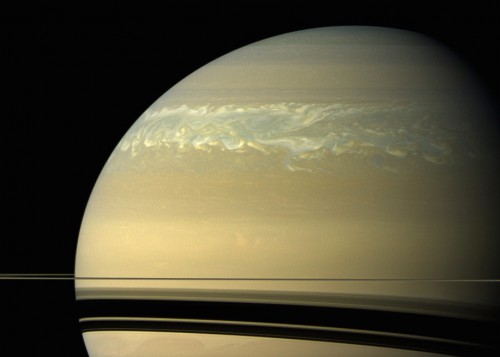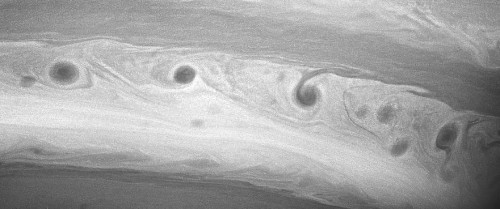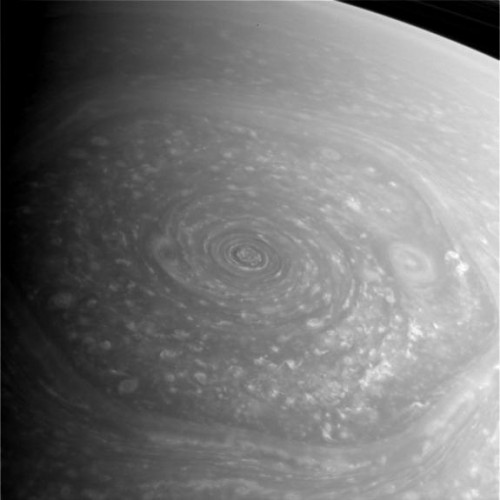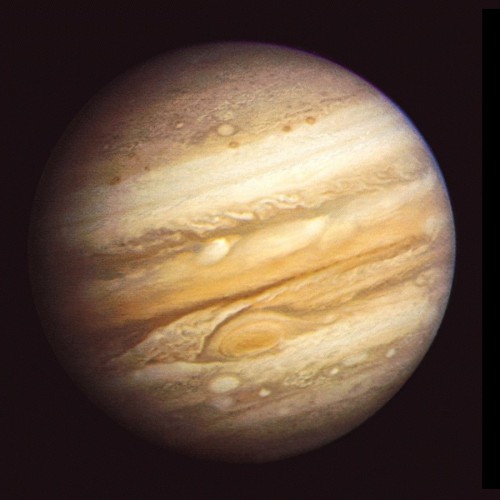
Thunderstorms are a powerful force of nature, but the ones we experience on Earth are dwarfed by the ones on the gas giant planet Saturn. They are huge and can be larger than Earth itself, and now scientists think they know why they tend to appear most prominently every 20-30 years, encircling the entire planet with intense lightning and massive cloud disturbances.
Saturn’s storms are also known as “great white spots,” an analogy to the Great Red Spot on Jupiter. There are, however, other differences: Jupiter’s spot does not have any lightning and is calm at the centre, like a hurricane on Earth. But Saturn’s spots are much more active, brimming with lightning and forming long “tails” or “storm alleys” which can wrap around the whole planet. Winds blow at hundreds of miles per hour and the lightning can be 10,000 times stronger than any seen on Earth!

During the past 140 years, astronomers have observed six such massive storms—the latest of which began in December 2010 and stretched around the planet within six months. The storms tend to alternate between the equator and mid-altitudes.
So what causes these enormous alien storms? Astronomers had noted that they occur when Saturn’s northern hemisphere is tilted toward the Sun. That was a clue, but now they think they better understand the process of just how they form.
The new study, called “Moist convection in hydrogen atmospheres and the frequency of Saturn’s giant storms,” was published April 13, 2015, in the advance online issue of the journal Nature Geoscience. It is supported by the National Science Foundation as well as NASA.
The explanation is fairly simple, according to the study. From the news release:
“Using numerical modeling, Professor of Planetary Science Andrew Ingersoll and his graduate student Cheng Li simulated the formation of the storms and found that they may be caused by the weight of the water molecules in the planet’s atmosphere. Because these water molecules are heavy compared to the hydrogen and helium that comprise most of the gas-giant planet’s atmosphere, they make the upper atmosphere lighter when they rain out, and that suppresses convection.”

This process leads to a cooling of the upper atmosphere over time. Eventually, however, that cooling overrides the suppressed convection, and warm, moist air rapidly rises, triggering a thunderstorm.
Ingersoll added, “The upper atmosphere is so cold and so massive that it takes 20 to 30 years for this cooling to trigger another storm.”
“For decades after one of these storms, the warm air in Saturn’s deep atmosphere is too wet, and too dense, to rise,” said Li. “The air above has to cool off, radiating its heat to space, before its density is greater than that of the hot, wet air below. This cooling process takes about 30 years, and then come the storms.”
That would explain why the storms are seen as infrequently as they are. The finding also matches observations by the Cassini spacecraft of the great white spot in 2010. It also helps to explain why such planet-wide storms are not seen on Jupiter—if Jupiter has less water vapor in its atmosphere. Saturated gas (gas that contains the maximum amount of moisture that it can hold at a particular temperature) first becomes less dense as the water precipitates out, and then becomes more dense as it cools, going through a “density minimum.”
According to Li, “Going through that minimum is key to suppressing the convection, but there has to be enough water vapor to start with.”
Observations from the Galileo spacecraft and the Hubble Space Telescope have already shown that Saturn does have enough water vapor for the density minimum process to work, but Jupiter does not. This ties in with other evidence for a wet interior:
“Previous studies using spectroscopy have shown that Saturn’s interior is enriched in methane and other volatiles, by two or three times, compared to Jupiter. From there, it’s a short leap to expect that Saturn is also rich in oxygen, which is also a volatile and a big part of every H2O molecule,” said Ingersoll.

The Juno spacecraft, which is currently en route to Jupiter, will be able to measure the water vapor abundance in the gas giant planet’s atmosphere more accurately starting in November 2016, which can then be compared to the Cassini data from Saturn. Juno will be the first spacecraft since Galileo to visit the Jupiter system.
“That should help us understand not only the meteorology but also the planet’s formation, since water is expected to be the third most abundant molecule after hydrogen and helium in a giant planet atmosphere,” Ingersoll said.
As well as the thunderstorms, there is also the bizarre and well-known hexagon-shaped weather system which rotates around Saturn’s north pole, one of the most visually stunning sights in the Solar System. At its centre is a circular hurricane-like wind system, similar to ones on Earth but larger.
Meanwhile, the Cassini spacecraft continues to orbit Saturn, studying that planet’s atmosphere and moons. It recently took new close-up images of the moon Rhea, showing the heavily cratered surface in sharp relief. Although quiet now, Rhea clearly has had a violent geological history. With no atmosphere, there is no erosion to erase the many impact craters on its surface. Cassini also imaged long, tenuous icy tendrils originating from the geysers on the moon Enceladus. The tendrils extend tens of thousands of miles into Saturn’s E ring. Scientists have even been able to identify which geyser a particular filament comes from. The tendrils can also provide new clues about the water sea or ocean beneath the surface which feeds the geysers.
Cassini is still in excellent health, orbiting Saturn every 28 days.
By studying storm systems on other planets like Saturn and Jupiter, scientists can learn more about atmospheric processes on planets in general, even exoplanets. Evidence for strong wind systems has already been found for some exoplanets in far-off solar systems. It is also a reminder that while storms on Earth can be bad and extremely dangerous, they still pale in comparison to storms on some other worlds, which would seem to be a good thing.
More information about the Cassini mission is available here.
Want to keep up-to-date with all things space? Be sure to “Like” AmericaSpace on Facebook and follow us on Twitter: @AmericaSpace




One Comment
One Ping
Pingback:Just add water: scientists explain Saturn's powerful thunderstorms